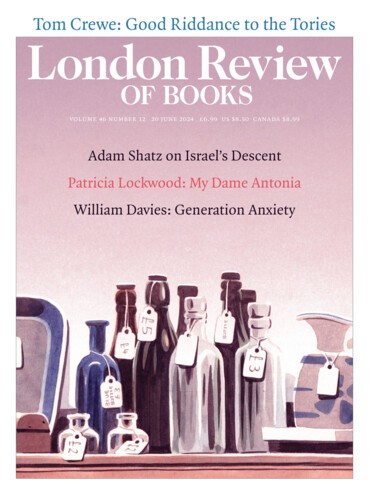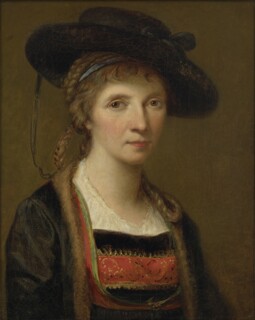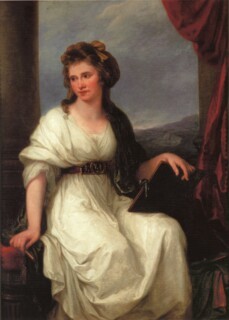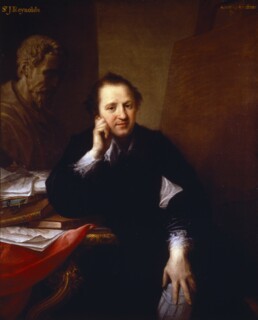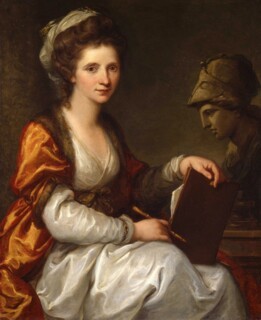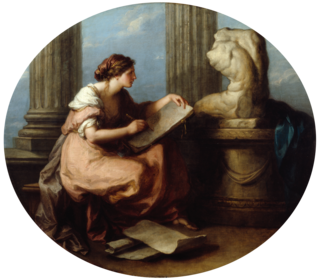In 1807, Angelica Kauffman’s body was carried in state to her funeral at the church of Sant’Andrea delle Fratte in Rome. A small army of priests, artists and dignitaries accompanied the coffin. Above the mourners, amid a sea of candles, two of her paintings were carried aloft in triumphal procession – a theatrical touch that echoed another funeral three centuries earlier, when Rome mourned the death of the ‘divine Raphael’. Such a comparison was an unusual honour for any artist, and especially for a woman, but Kauffman was seen as a prodigious exception to her gender. She was famous across Europe, a favourite of art academies and royal courts alike. After her bust was placed next to Raphael’s in the Pantheon, her art historical canonisation seemed assured.
Few today would place Kauffman in the same company as Raphael. Although she was one of just two female founder members of the Royal Academy of Arts in London, Angelica Kauffman (until 30 June) is the first solo show of her work to be held at her home institution. Kauffman’s neoclassical history paintings have long been unfashionable, and her images of mourning women, heads bowed over urns or red-rimmed eyes flung heavenwards, seem sentimental and melodramatic to modern tastes. Her portraits, in which she often cast her (mostly female) clientele as Grecian goddesses or muses, could be accused of favouring classical cosplay over psychological penetration. But one aspect of Kauffman’s work – her self-portraiture – still speaks vividly to viewers.
On entering the RA show, the visitor encounters two self-portraits, both painted when she was in her forties, that explore different sides of Kauffman’s identity. In the first, she wears the typical embroidered dress and black felt hat of her father’s native Bregenzerwald in Austria. Although she was born in Switzerland, grew up in Lombardy and spent most of her professional life in London and Rome, Kauffman didn’t forget her Austrian roots. She shows herself without flattery, and her direct gaze suggests that foreign pretensions have been stripped away. This private painting is a rarity among her self-portraits, most of which are obviously idealised and resist the specificities of time and place. An example hangs on the adjoining wall: Kauffman appears as a classically dressed maiden with a wistful look, a portfolio in one hand and a stylus (which held chalk or graphite for drawing) in the other. In a painting by a man, such a figure would be assumed to be an allegory or muse of painting, but Kauffman maps these visual traditions onto her own image, portraying herself as both muse and artist. Her features are perfected not simply out of vanity, but in accordance with the tradition, extending back through Raphael to antiquity, that artists make visible the divine ideal that lies behind nature. This painting was made specifically for the Uffizi’s gallery of artists’ self-portraits (which also included Raphael) – a fitting public forum for Kauffman’s bold claim to embody art rather than merely practising it.
Kauffman returned repeatedly to her own image. She painted her first self-portrait in 1753, at the age of twelve, and her last in 1801, when she was sixty. She was aware from the start of her unusual position as a female artist with ambitions beyond contemporary expectations. Her father, the Austrian painter Johann Joseph Kauffman, encouraged her talents, giving her an artistic, literary and musical education to which few women had access. After chaperoning her around Italy, he followed her to London, helping to manage her career as it far eclipsed his own. Even her name – Angelica – seemed to have been chosen in prediction of a brilliant future. Her ‘angelic’ grace, beauty and sweet disposition contributed to her image as an artist, just as Raphael’s good looks and amiable temperament had contributed to his: Johann Gottfried Herder called her a ‘heavenly creature’ and ‘perhaps the most cultivated woman in the whole of Europe’. And like Raphael, Kauffman became one of those artists who in their lifetime are known and recognised by their first name alone: ‘Angelica’ by name and by nature.
Kauffman used portraiture not only to shape her public image, but also to embed herself within networks of mutually supportive artists and thinkers. Her paintings of David Garrick and Johann Joachim Winckelmann, made in Rome early in her career, helped to establish her fame in Britain, where she moved in 1766. Shortly after she arrived, her portrait was painted by Joshua Reynolds, soon to be president of the Royal Academy; Kauffman consolidated their friendship by painting him in return. In her portrait, Reynolds is surrounded by the flattering trappings of art and intellect, including a bust of his hero, Michelangelo. But the painting is also charged with unexpected intimacy: Reynolds’s left hand, placed on his knee at the very front of the picture plane, feels close and fleshy, creating creases in his silk stocking as it presses down on the fabric. Thirteen years later, their conversation was still continuing: after Reynolds painted his grandiloquent self-portrait in academic robes with the same bust of Michelangelo, Kauffman portrayed herself wearing luxurious fur-trimmed robes of her own. Instead of Michelangelo, she is watched over by Minerva, the virgin warrior goddess of wisdom. From the portfolio in Kauffman’s hands, the corner of a piece of paper peeps out, like the tip of a tongue emerging from barely parted lips. This paper forms one of the brightest spots in the whole composition; while its whiteness suggests purity, its placement is tantalising; we long to see what she has drawn on the other side. Kauffman’s paintings have often been derided as flat and formulaic, but they are just as often energetic and animated by restrained eros.
The ease with which Kauffman gained friends and admirers, as well as her ability to convey closeness and complicity in her portraits, stoked jealousy among her rivals. Had she used her feminine wiles, or even compromised her virtue, to ascend the slippery slope of academic favour? Scurrilous critics attributed her membership of the Royal Academy and her prominence at its annual exhibitions to an improper relationship with Reynolds. Things came to a head in 1775, when Nathaniel Hone submitted a painting to the annual exhibition that took aim at Reynolds’s dominance: Kauffman thought she recognised herself among a group of cavorting, naked artists depicted in the background. To have her honour impugned in the satirical press was one thing, but to have it done on the walls of the Academy was quite another. Her response was quick and uncompromising. If Hone’s painting was displayed, she told the committee, she would withdraw every one of her canvases from the exhibition, depriving it of her power to attract the viewing (and buying) public.
Kauffman won the battle, but it was only the most visible of many attacks on her character. This was a time when for a woman the very act of looking was fraught. An exchange of portraits necessitated an exchange of meaningful looks, a mutual examination of form that often carried a whiff of scandal. Artistic education at the Royal Academy involved the extensive study of the male body, through nude classical sculptures and naked life models: if the former were thought to be potentially unsettling to delicate female sensibilities, the latter were actively forbidden to women. Despite this, Kauffman carved out a career as a history painter, a genre traditionally underpinned by the anatomical understanding of the (mostly male) form. While many commentators marvelled at her gender-defying ability to produce edifying scenes of myth and legend, others sneered at her lack of anatomical expertise and the effeminacy of her male figures. Even worse, some critics implied that what knowledge she did have was gained through carnal rather than artistic education.
Kauffman’s status for much of her life as an unmarried woman laid her particularly open to insinuation, but marriage itself yielded little comfort, at least at first. In 1767, shortly after arriving in London, she was groomed by a conman and bigamist who styled himself with sinister panache as the Count Frederick de Horn. She only realised her mistake after she had married him in secret. The marriage was swiftly annulled and Kauffman escaped with her reputation intact, but the gossip continued. When she finally married again, in 1781, she chose someone less likely to set tongues wagging: the decorative painter Antonio Zucchi, a family friend fifteen years her senior. Zucchi dedicated himself to supporting her work, and Kauffman retained both her name and her financial independence.
As if to counter the idea that the female body and mind were inherently feeble and corruptible, Kauffman swapped the typically male heroes of history painting for female ones. She mined mythology and early British history for stories of gritty, determined women such as Eleanor of Castile, who allegedly saved her husband, Edward I, by sucking the venom from a poisoned knife out of his arm. By pursuing history painting, Kauffman also defied the stereotype that, because their imaginations were reproductive and imitative rather than creative, women could only work in the ‘lower’ genres of portraiture and still life. At the same time, she turned both reproduction and imitation into virtues rather than marks of insufficiency. She worked with engravers who helped to spread her fame through prints of her designs, particularly in the fashionable new medium of stipple engraving, which emulated the texture of chalk drawing. Only a select few could have a Kauffman painting on their wall, but her prints were widely available and particularly popular with female buyers. Her compositions proliferated not only in print, but also in embroidery, ceramics, marquetry, enamelled snuffboxes and fans, copied by both amateur artists and professional artisans. This work is not represented in the RA show. Perhaps these less exalted media – and the women who made and consumed them – continue to carry the taint of frivolity and empty decoration, of second-hand diffusion rather than original authorship.
Kauffman, however, placed imitation at the heart of the creative process in the four monumental roundels she painted in 1780 for the ceiling of the Royal Academy’s Council Room at Somerset House. (They were later moved to the entrance hall of the RA’s new home in Burlington House; two are currently on show at Tate Britain’s exhibition Now You See Us: Women Artists in Britain, 1520-1920.) Kauffman’s gender made her ineligible to join the council’s discussions, but the prominent commission allowed her to make her presence felt from above. The series depicts the four ‘elements’ of art – ‘Invention’, ‘Design’, ‘Composition’ and ‘Colouring’ – as women in the allegorical mode, but Kauffman injects them with a life and depth beyond standard iconographies, almost turning them into sublimated self-portraits. In Design, a woman is shown in the act of drawing the Belvedere Torso, the hunky remains of an ancient male nude sculpture unearthed in Rome in the 15th century. Somewhat surprisingly, the original torso’s forms are reversed, suggesting that Kauffman used a print as the source for her image – perhaps as a subtle demonstration of the power of artistic reproduction. Nonetheless, there is a crackling physical energy between the artist and her chiselled sitter: this is an act of inspired translation rather than rote imitation.
Kauffman’s compulsive return to her own image could be seen as a defence against the many competing ideas of her that circulated in her lifetime, a way of asserting her agency while bolstering the ‘angelic’ identity she had worked so hard to cultivate. But the stage management of her public persona was balanced with an exploration of female creativity and the risky yet productive borderlands between the professional and the personal. The unusually expressive hands that draw the eye in her self-portraits are also the agents of unseen labour. Again and again, Kauffman portrays herself holding a stylus and portfolio, the symbols not of painting but of drawing, of the intellectual and imaginative efforts that precede the messy work of the brush. In her roundel of Design, we finally see those tools put to active use: the artist grips the stylus between her fingers and balances her portfolio on her knee, totally absorbed in her task. She might be a classical fantasy in sandals and cascading drapery, but her sleeves are rolled up. It takes a lot of hard work, she seems to be saying, to look this good.
Send Letters To:
The Editor
London Review of Books,
28 Little Russell Street
London, WC1A 2HN
letters@lrb.co.uk
Please include name, address, and a telephone number.
